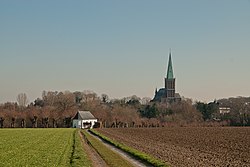You can help expand this article with text translated from the corresponding article in German. (March 2009) Click [show] for important translation instructions.
|
Heinsberg (German: [ˈhaɪnsbɛʁk] ⓘ; Limburgish: Hinsberg [ˈɦɪnzˌbæʀ˦(ə)x])[tone?] is a town in North Rhine-Westphalia, Germany. It is the seat of the district Heinsberg. It is situated near the border with the Netherlands, on the river Wurm, approx. 20 km north-east of Sittard and 30 km south-west of Mönchengladbach.
Heinsberg | |
|---|---|
 | |
Location of Heinsberg within Heinsberg district  | |
| Coordinates: 51°03′47″N 06°05′47″E / 51.06306°N 6.09639°E | |
| Country | Germany |
| State | North Rhine-Westphalia |
| Admin. region | Köln |
| District | Heinsberg |
| Subdivisions | 14 |
| Government | |
| • Mayor (2020–25) | Kai Louis[1] (CDU) |
| Area | |
| • Total | 92.14 km2 (35.58 sq mi) |
| Elevation | 76 m (249 ft) |
| Population (2022-12-31)[2] | |
| • Total | 43,476 |
| • Density | 470/km2 (1,200/sq mi) |
| Time zone | UTC+01:00 (CET) |
| • Summer (DST) | UTC+02:00 (CEST) |
| Postal codes | 52525 |
| Dialling codes | 02452 |
| Vehicle registration | HS |
| Website | www.heinsberg.de |
Geography edit
Wassenberg is the town to the north of Heinsberg, Hückelhoven to the east, Waldfeucht and Gangelt to the west, and Geilenkirchen to the south. Two rivers flow through Heinsberg, the Wurm and the Rur. The Wurm flows into the Rur near to Rurkempen, a village of Heinsberg municipality.
History edit
Lordship of Heinsberg 1085–1484
Duchy of Jülich-Berg 1484–1794, part of:
United Duchies of Jülich-Cleves-Berg 1521–1614
Palatinate-Neuburg 1614–1685
Electoral Palatinate 1685–1794, part of:
Electorate of Bavaria 1777–1794
French Republic 1794–1804
French Empire 1804–1815
Kingdom of Prussia 1815–1871
German Empire 1871–1918
Weimar Republic 1918–1933
Nazi Germany 1933–1945
Allied-occupied Germany 1945–1949
West Germany 1949–1990
Germany 1990–present
Economy edit
Due to its proximity to the Benelux countries, sufficient industrial park areas, low trade tax and good traffic connections, Heinsberg has good prerequisites for development.[original research?] Companies include:
- Enka Gmbh & Co KG
- Hazet (tool company)
- Sera Aquaristic
Sights edit
The city of Heinsberg has just a few ancient structures. Most of the city was destroyed in 1944 during World War II. The main sights are:
- St. Gangolf church
- Castle ruins
- Old district court
- Building assembly of Propstei, Torbogenhaus (former seat of the Amtmann of the Duchy of Jülich) and the former Haus Lennartz.
Transport edit
Railway edit
The railway from Heinsberg to Lindern, on the Aachen–Mönchengladbach railway, was reopened for passenger traffic in December 2013. Passenger traffic had been suspended in 1980.[3] As of 2015[update], there is an hourly service from Heinsberg station to Lindern, which continues to Aachen Hbf.[4]
Bus edit
The main bus station of Heinsberg is next to the train station. It is served by buses to several towns and villages in the district, including Erkelenz, Geilenkirchen, Wegberg, Gangelt, Waldfeucht and Selfkant-Tüddern. There is one swift bus, the SB 1 from Erkelenz to Geilenkirchen via Heinsberg.
Road edit
Heinsberg has two exits on the motorway A46 to Düsseldorf. The Bundesstraße 221 (Alsdorf–Straelen) passes through the town.
Public facilities edit
- office of the district Heinsberg
- police (district)
- the district court
- health office
- jail
Education and training edit
Heinsberg possesses many elementary schools and kindergartens. The secondary education facilities include a high school (Gymnasium). Since 2007 there is a school for disabled persons in the building of the former vocational school (Berufsschule).
Media edit
- Heinsberger newspaper
- Hs-Woche, a free weekly newspaper
- "Lokalzeit aus Aachen", a news broadcast from the WDR about Aachen and also Heinsberg
- HS TV, a television transmitter
- The radio transmitter Welle West was closed in 2007. Other radio stations, which include 100.5 and 107.8, provide news and weather reports for Heinsberg.
Heinsberg COVID-19 study edit
Heinsberg was an early centre for the COVID‑19 pandemic and was selected for an intensive study of the disease and its transmission characteristics in late‑March 2020.[5]
Twin towns – sister cities edit
- Ozimek, Poland
See also edit
References edit
- ^ Wahlergebnisse in NRW Kommunalwahlen 2020, Land Nordrhein-Westfalen, accessed 21 June 2021.
- ^ "Bevölkerung der Gemeinden Nordrhein-Westfalens am 31. Dezember 2022 – Fortschreibung des Bevölkerungsstandes auf Basis des Zensus vom 9. Mai 2011" (in German). Landesbetrieb Information und Technik NRW. Retrieved 20 June 2023.
- ^ wurmtalbahn.de
- ^ Deutsche Bahn timetable 485
- ^ Connolly, Kate (31 March 2020). "Worst-hit German district to become coronavirus 'laboratory'". The Guardian. London, United Kingdom. ISSN 0261-3077. Retrieved 2020-04-08.
- ^ "Partnerstadt Ozimek". heinsberg.de (in German). Heinsberg. Retrieved 2021-02-14.
External links edit
- Official site (in German)


